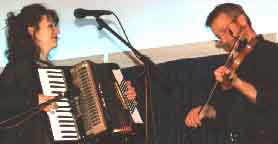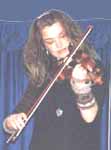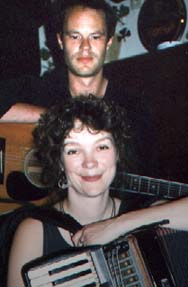FolkWorld article by Christian & Michael Moll:
Swedish Swapping
Swåp about differences and similarities between Irish and Swedish music
 The foyer of the Gaul-Roman Museum, just beneath Cologne Cathedral; a place full of history is the setting for this interview. Just the right place to talk about very old relationships between two very old music cultures, between Swedish and Irish traditions. We met the two Swedish fiddlers Ole Backström and Carina Normansson, and the English accordionist Karen Tweed and guitarist Ian Carr, who are together known as Swåp. This band has experienced the challenge trying to learn with a Swedish background Irish music, and with an English-Irish background Swedish music.
The foyer of the Gaul-Roman Museum, just beneath Cologne Cathedral; a place full of history is the setting for this interview. Just the right place to talk about very old relationships between two very old music cultures, between Swedish and Irish traditions. We met the two Swedish fiddlers Ole Backström and Carina Normansson, and the English accordionist Karen Tweed and guitarist Ian Carr, who are together known as Swåp. This band has experienced the challenge trying to learn with a Swedish background Irish music, and with an English-Irish background Swedish music.
When Swåp started, the idea was how it would sound when Swedish musicians and British musicians meet, and Celtic and Swedish music meets; what will happen. And which things do the two music cultures have in common, and which ones are different. They made quite interesting experiences, while the music itself developed - "the more we were playing, the more it became our own music, swåppish music. Of course it is built upon our traditions, but it's music where you can't say if it's Swedish or if it's British. It's just folk music.
Ian and Karen, with their English Irish background, wanted to learn Swedish music, and Ole and Carina Irish music.
"Ole is very interested in Irish tunes, the kind of more minor mode Irish tunes, explains Karen, "because there is kind of relationship to the Swedish music that Ole plays. He plays a lot of music from the Central and Northern parts of Sweden, not specifically from the Southern parts. And there is that kind of minory spookyness about the music there, which can also be found in Paddy Fahy modes, you know Fahy tunes have that kind of weirdness about them.
 Carina says that it is very hard for her to play Irish music; you have to listen really carefully to try and hear the basics in the music. "It's really different - Swedish music is upside down with Irish music. It's definitely a big difference in the bowing, and it's definitely a hard thing to learn the bowing from a guitar player anyway, she says with a smiling glimpse to Ian.
Carina says that it is very hard for her to play Irish music; you have to listen really carefully to try and hear the basics in the music. "It's really different - Swedish music is upside down with Irish music. It's definitely a big difference in the bowing, and it's definitely a hard thing to learn the bowing from a guitar player anyway, she says with a smiling glimpse to Ian.
It was interesting when they started rehearsing as Swåp; Karen: "Every time they taught us a Swedish tune, when we played it back to them it sounded English, it wouldn't sound Swedish. And they could spend a long time teaching us that Swedish tune, but it wouldn't sound like a Swedish person would play it, because we are not Swedish. And when they played Irish music to us, it wouldn't sound like say Tommy peoples or Sharon Shannon or whoever would play, it sounded Swedish. They decided not to try and fight back that kind of thing, but to explode it more. Ian think that this is good in a way for the music, not really to try hard to play Swedish music in a Swedish way and Irish music in an Irish way. "Me and Karen like it when these two play Irish tunes in a Swedish way, with the bowing in a Swedish way, and with that kind of feeling. We don't try to copy at all, we are tying to give it a heavy accent.
Ole adds: "I just play the thing I can play, the Swedish music, and I think whatever I try to play, there will always be a Swedish kind of style in it. And that is what we all try to keep as a value.
 ( Ian Carr und Karen Tweed, Photo by The Mollis)
At the same time, Ole states that in a way the music of the four musicians is very closely related, in the general approach and attitude to music. It is more far away for him to play with a Swedish classical or Jazz musician than to play with English folk musicians. "I think playing folk music - equally if you do it in Scandinavia or Britain or Germany - I think it is all kind of a community; folk musicians have a common language, because we are all from the same background.
( Ian Carr und Karen Tweed, Photo by The Mollis)
At the same time, Ole states that in a way the music of the four musicians is very closely related, in the general approach and attitude to music. It is more far away for him to play with a Swedish classical or Jazz musician than to play with English folk musicians. "I think playing folk music - equally if you do it in Scandinavia or Britain or Germany - I think it is all kind of a community; folk musicians have a common language, because we are all from the same background.
Although in Sweden both the Irish and Swedish music scenes are related, Ole thinks that there is a certain Irish/Celtic scene in Sweden, and another scene of its own for more Scandinavian music. "They are a bit two different sorts of cultures. You find most folk musicians playing either Irish music or Swedish music, but not both.
Both scenes are now very healthy. Irish Music in Sweden has had a big boom in the Seventies, and has always been strong but has not grown since then. The Swedish music scene also had a boom in the Seventies, but it went down then. Since about five years it is rising very much; and is very strong now; one example for this is that now the music conservatories offer also Swedish folk music educations. "Swedish music has another value now. Before, it was just classical music, now it's also folk music. Many people are playing, many young people are starting. Also in the Irish scene, but not as active as in the Swedish scene for the moment.
 While we have spoken up to now about the differences between Irish/British and Swedish traditional music, we come to the relations, going back into far away history. For example, you can find out that Irish slipjigs are very similar to Swedish polskas. Ole has discussed this issue with the Boys of the Lough some time. "Slipjigs are an older form, the older jigs. And slipjigs and polskas - 9/8 Polskas - have basically the same rhythm, they are very similar. Before Ole explained that polskas and slipjigs were very similar, Karen was trying really hard to understand polskas, she couldn't really get the beat. "Suddenly he said to me well slipjigs are the same: one - two - three - one - two - three. And suddenly it was very clear. But it didn't appear to me before, that the polska is like a slipjig, because I was probably looking too hard into a music I found so totally different.
While we have spoken up to now about the differences between Irish/British and Swedish traditional music, we come to the relations, going back into far away history. For example, you can find out that Irish slipjigs are very similar to Swedish polskas. Ole has discussed this issue with the Boys of the Lough some time. "Slipjigs are an older form, the older jigs. And slipjigs and polskas - 9/8 Polskas - have basically the same rhythm, they are very similar. Before Ole explained that polskas and slipjigs were very similar, Karen was trying really hard to understand polskas, she couldn't really get the beat. "Suddenly he said to me well slipjigs are the same: one - two - three - one - two - three. And suddenly it was very clear. But it didn't appear to me before, that the polska is like a slipjig, because I was probably looking too hard into a music I found so totally different.
Other tunes that can be found in both traditions are Polkas and Waltzes; and the Swedish 6/8 Halling is very rhythmically very close to the Irish Jig. We are starting to discuss if this just is a coincidence. "It seems to be more interesting than that, Karen thinks, "finding out that slipjig is an older form of music... Ole: "Maybe the music has been before the Vikings; it is found in Norway, and Shetland and Ireland. So the reason for the similarities might be very old.
"The Vikings - they were quite everywhere. They were quite rude people. But they played a lot of music, and drank a lot of alcohol. describes Karen. "So what we don't know is whether Irish music was started by the Vikings - this is the question. What happened in Ireland before? This is a little question for all Irish Music magazine readers: What music was there in Ireland before the Vikings came? Or did the Vikings nick all these tunes and take it back to Scandinavia?
 Another interesting tune to examine its origin is the Schottische, which is found in Sweden as well as in Scotland and Northern Ireland; also, the Irish barndances are little bit like Schottisches. The exciting point is that you find Schottisches also in Germany as common dances. As Jo Meyer, of the popular German folk band Jams, says "The Schottische has been one of the most common dances in Germany until well after World War 2. But there is also the Highland Schottische in Scotland, with the same dance and the same rhythm. Schottische has been widely spread throughout Northern Europe in the last century, and there are many discussions about the origin. At least the name Schottische seems not to have the word 'Scottish' as origin, but the Low German word 'Schottschen' which means 'dancing'. And you can find in Sweden Schottisches called 'Hamburg' and 'Engelska', so it's a Schottische as it has been played in Hamburg and England.
Another interesting tune to examine its origin is the Schottische, which is found in Sweden as well as in Scotland and Northern Ireland; also, the Irish barndances are little bit like Schottisches. The exciting point is that you find Schottisches also in Germany as common dances. As Jo Meyer, of the popular German folk band Jams, says "The Schottische has been one of the most common dances in Germany until well after World War 2. But there is also the Highland Schottische in Scotland, with the same dance and the same rhythm. Schottische has been widely spread throughout Northern Europe in the last century, and there are many discussions about the origin. At least the name Schottische seems not to have the word 'Scottish' as origin, but the Low German word 'Schottschen' which means 'dancing'. And you can find in Sweden Schottisches called 'Hamburg' and 'Engelska', so it's a Schottische as it has been played in Hamburg and England.
It seems like all our European music cultures have more in common and are closer related than most of us would have thought. Exciting enough to find out that our folk tunes are all just a big family with just their very own pecularities, especially in these days where Europe grows together...
Photo Credit: All photos by the Mollis.
Further Information: Swåps Hompage e-mail Karen Tweed.
Back to the content of FolkWorld Articles & live reviews
To the content of FolkWorld online magazine Nr. 8
© The Mollis - Editors of FolkWorld; Published 2/99
All material published in FolkWorld is © The Author via FolkWorld. Storage for private use is allowed and welcome. Reviews and extracts of up to 200 words may be freely quoted and reproduced, if source and author are acknowledged. For any other reproduction please ask the Editors for permission.
FolkWorld - Home of European Music

Layout & Idea of FolkWorld © The Mollis - Editors of FolkWorld
 The foyer of the Gaul-Roman Museum, just beneath Cologne Cathedral; a place full of history is the setting for this interview. Just the right place to talk about very old relationships between two very old music cultures, between Swedish and Irish traditions. We met the two Swedish fiddlers Ole Backström and Carina Normansson, and the English accordionist Karen Tweed and guitarist Ian Carr, who are together known as Swåp. This band has experienced the challenge trying to learn with a Swedish background Irish music, and with an English-Irish background Swedish music.
The foyer of the Gaul-Roman Museum, just beneath Cologne Cathedral; a place full of history is the setting for this interview. Just the right place to talk about very old relationships between two very old music cultures, between Swedish and Irish traditions. We met the two Swedish fiddlers Ole Backström and Carina Normansson, and the English accordionist Karen Tweed and guitarist Ian Carr, who are together known as Swåp. This band has experienced the challenge trying to learn with a Swedish background Irish music, and with an English-Irish background Swedish music.
 Carina says that it is very hard for her to play Irish music; you have to listen really carefully to try and hear the basics in the music. "It's really different - Swedish music is upside down with Irish music. It's definitely a big difference in the bowing, and it's definitely a hard thing to learn the bowing from a guitar player anyway, she says with a smiling glimpse to Ian.
Carina says that it is very hard for her to play Irish music; you have to listen really carefully to try and hear the basics in the music. "It's really different - Swedish music is upside down with Irish music. It's definitely a big difference in the bowing, and it's definitely a hard thing to learn the bowing from a guitar player anyway, she says with a smiling glimpse to Ian.  ( Ian Carr und Karen Tweed, Photo by The Mollis)
At the same time, Ole states that in a way the music of the four musicians is very closely related, in the general approach and attitude to music. It is more far away for him to play with a Swedish classical or Jazz musician than to play with English folk musicians. "I think playing folk music - equally if you do it in Scandinavia or Britain or Germany - I think it is all kind of a community; folk musicians have a common language, because we are all from the same background.
( Ian Carr und Karen Tweed, Photo by The Mollis)
At the same time, Ole states that in a way the music of the four musicians is very closely related, in the general approach and attitude to music. It is more far away for him to play with a Swedish classical or Jazz musician than to play with English folk musicians. "I think playing folk music - equally if you do it in Scandinavia or Britain or Germany - I think it is all kind of a community; folk musicians have a common language, because we are all from the same background. 